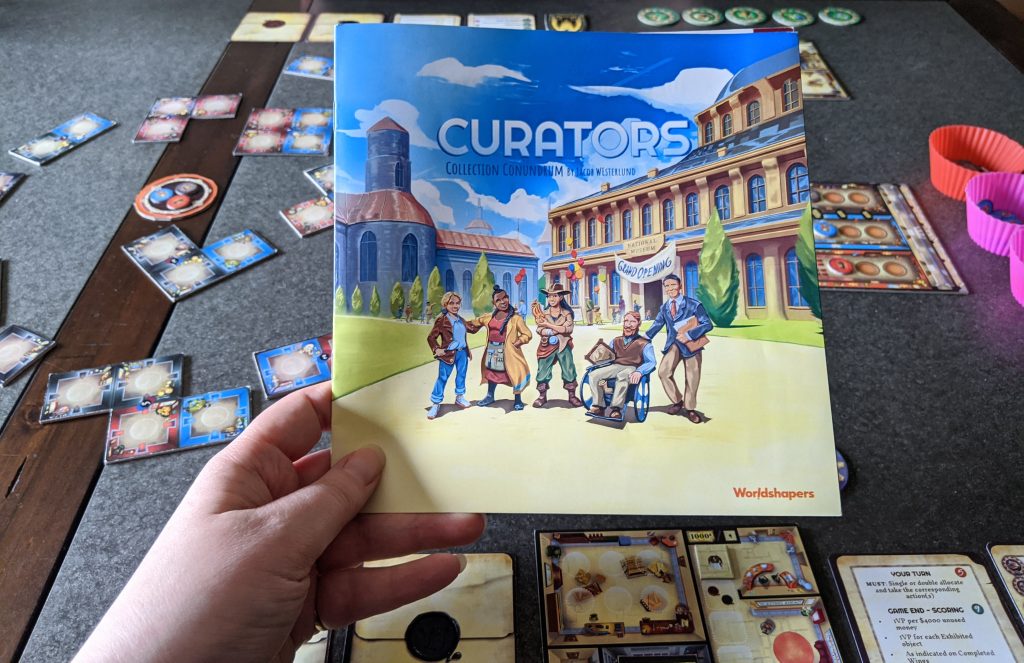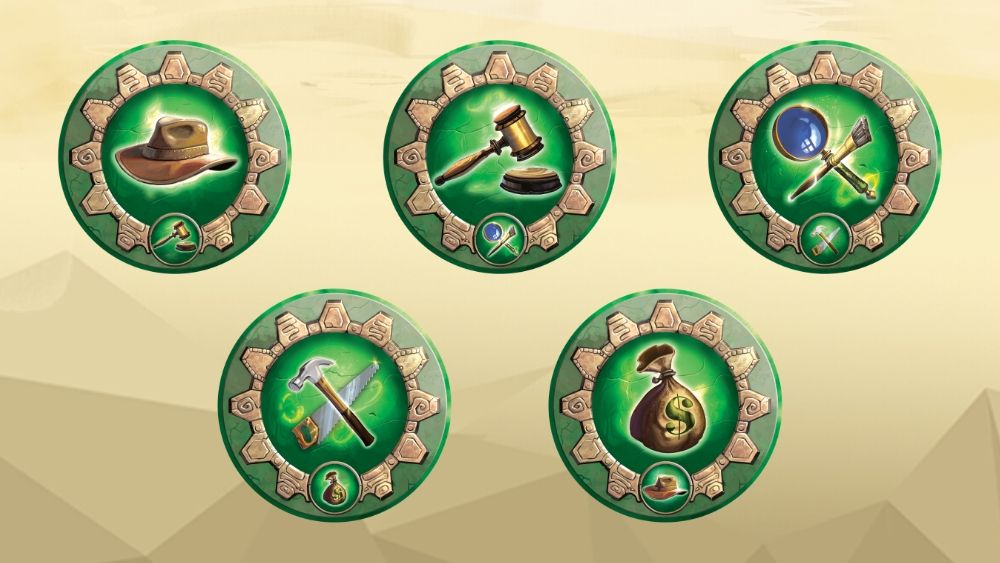I received a prototype copy of Curators to play for the purposes of writing this preview. The prototype was sent on to another content creator when I was finished with it. Prototype components are not final.
Curators is a tile-placement, pattern matching, action selection game for 1-4 players about museum collection curation. You’ll need to source artifacts, build museum wings, and get the artifacts out of storage for display. Of course, doing all of this is going to require funds and getting funds requires visitors. The player who can puzzle out how to build the museum that earns the most points wins the Museum of the Year award.
- Designer: Jacob Westerlund
- Artists: Emilie Vaccarini Francis, Niklas Wallén
- Publisher: Worldshapers
- Curators on BoardGameGeek
- Curators on Kickstarter (April 21, 2020 – May 21, 2020)

Rebecca’s Thoughts
I first became interested in this game when I was judging the 2019 Board Game Workshop design contest and saw it as a submission. Curators went on to win that design contest. When the publisher was looking for coverage for their Kickstarter, I was happy to be included on the list of folks getting to try this game out prior to launch.

During setup, the available wings that can be used to build your museum are arranged in a spiral configuration. The outside end is free to build and if you want to build a tile further into the spiral, you’ll need to pay $1000 per tile you skip. The end of the game is triggered when the last wing is taken. Players will complete two more rounds after the last wing is taken from the spiral and then they will complete scoring.

When building your museum, you’ll be attempting to fulfill specific build contracts that require rooms to be arranged in specific color patterns. The contract orientations can be rotated within the museum and multiple contracts can overlap for completion (in fact, it is usually more convenient if you can get your contracts to overlap!). Players start the game with two contacts and can earn up to two more by fillings wings with objects to attract visitors.
On a players turn, they can take one action by selecting one employee type from their available museum staff. All players start with five double-sided employee chips that indicate which employees are available to work on a given turn. When an employee’s ability is used for the player action, the employee chip is flipped over, which makes a different employee available on the player’s next turn (each side shows a large icon for the available employee and a smaller icon to show which employee will be available when flipped). If a player ever has two of the same employees available on a turn, the player can execute that employee action twice.

This employee chip flipping mechanism is the heart of the puzzle of this game for me. It was so fun trying to make sure that I would have the appropriate employees available at the right time in order to maximize my actions and build the best museum.
Archeologists find objects that are placed in the players storage and in the auction house. Collection Managers buy objects from the auction house. Restorers clean objects in storage and place them in the exhibit wings. Carpenters build wings from the spiral of available wing tiles. Financial Managers collect money from visitors. Using these five abilities, it is up to the player to make sure they have the right staff available to get the work done to become Museum of the Year.

Curators is a fun puzzley game that plays quickly and is easy to learn, teach, and set up. Greg and I played this game with 2 players. (We were unable to play with 3-4 players due to shelter-in-place orders because of the COVID-19 pandemic.) I believe that this game will shine best at its higher player counts. (Greg also played the solo version, which he shares his thoughts on below.) With two players, we found that it was fairly easy for a single player to grab up the high point wing tiles, which can create a point gap that is too large to overcome even if the other player completes high point contracts. That said, I loved playing the game and very much look forward to being able to play it with more people.
I love the employee chip puzzle – it provides just the right amount of strategy for what is, overall, a light tile-placement game. I could easily play this several times in a row without getting bored of it or burned out. I also enjoy trying to get my building contracts as tight as possible so that I can build efficiently and get more objects and visitors into the museum.
There are a few “advanced rules” options players can optionally add to the game that reward additional points at the end of the game for specific objectives. These are great ways to add some variety to the game. Or, as a house rule, if you are playing as a family and have wide age/experience ranges, you could give a boost to less experienced players to level the playing field a bit.
Also, just look at that box cover art! I cannot wait to see what the final version of the game looks like.
Greg’s Thoughts
Curators is easy-to-learn and has a pleasant depth to it. It contains two puzzles that interlink well. One is the action selection method which rewards planning ahead one’s actions. The second is the polyomino tile placement that makes up the museum.
In multiplayer mode, strategy is required to get the tiles (museum wings) best suited for your needs. The hidden goals force players to observe the actions of others to deduce which objects they are trying to exhibit in their museum. There is an enjoyable tension between players in competing for wings and objects.
In solo mode, Curators becomes a choice of puzzles to solve. There are various missions for the player to take on, each with their own goals and game-play variations. The player is tasked with achieving the best score in a limited number of turns. I found this mode to be enjoyable and challenging. While the contention for wings and objects between players is not present, finding the best paths within the constraints of each of the missions is engaging. The quick game-play left me wanting to give it one more try to refine my actions.
I find the action selection to be a great mechanic, rewarding a rhythm of actions. This pattern is not simply repeated as there are meaningful choices in the flow of actions. Should I send out my archaeologists to populate the auction house and my own personal storage or send in my acquisition team to purchase objects at auction or should the money go to carpenters to add wings to allow space to exhibit more objects. More exhibited objects results in more visitors, which is needed to bring money into one’s museum.
If it isn’t obvious from the above description, the theme of running a museum fits beautifully with the game mechanics. There is a nice progression through the game of building wings to exhibit objects to attract visitors to make money to build more wing or objects at auctions. The archaeologists bring objects to the auction house as well as one’s personal museum storage but buying from the auction house allows for more objects to be acquired in a single action. Finding the right timing for the actions not only results in stronger actions but in a more efficient museum which will score better.
Find the Game
- Curators on Kickstarter (April 21, 2020 – May 21, 2020)
- Worldshapers website
- Curators on BoardGameGeek
